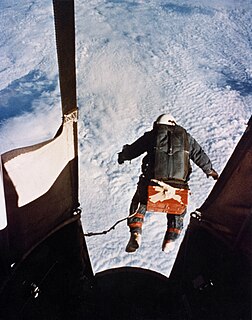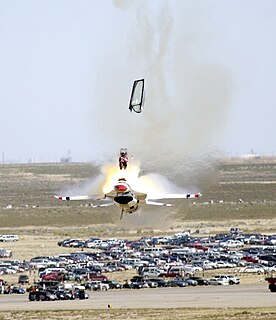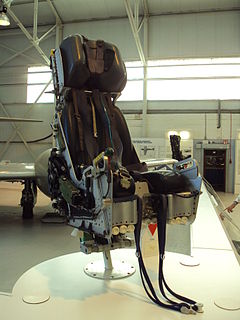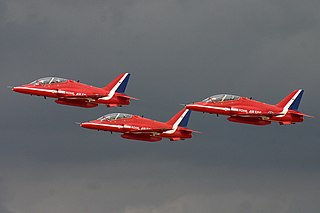
The Supermarine Seafire was a naval version of the Supermarine Spitfire adapted for operation from aircraft carriers. It was analogous in concept to the Hawker Sea Hurricane, a navalised version of the Spitfire's stablemate, the Hawker Hurricane. The name Seafire was derived from the abbreviation of the longer name Sea Spitfire.

In aircraft, an ejection seat or ejector seat is a system designed to rescue the pilot or other crew of an aircraft in an emergency. In most designs, the seat is propelled out of the aircraft by an explosive charge or rocket motor, carrying the pilot with it. The concept of an ejectable escape crew capsule has also been tried. Once clear of the aircraft, the ejection seat deploys a parachute. Ejection seats are common on certain types of military aircraft.
Martin-Baker Aircraft Co. Ltd. is a British manufacturer of ejection seats and safety-related equipment for aviation. The company's origins were originally as an aircraft manufacturer before becoming a pioneer in the field of ejection seats. The company's headquarters are in Higher Denham, Buckinghamshire, England with other sites in France, Italy and the United States.

The Supermarine Swift is a British single-seat jet fighter aircraft that was operated by the Royal Air Force (RAF). It was developed and manufactured by Supermarine during the 1940s and 1950s. The Swift featured many of the new jet age innovations, such as a swept wing. On 26 September 1953, a Swift F.4 piloted by Commander Mike Lithgow broke the world absolute speed record, reaching a speed of 737.7 mph (1,187 km/h).

Project Excelsior was a series of parachute jumps made by Joseph Kittinger of the United States Air Force in 1959 and 1960 from helium balloons in the stratosphere. The purpose was to test the Beaupre multi-stage parachute system intended to be used by pilots ejecting from high altitude. In one of these jumps Kittinger set world records for the longest parachute drogue fall, the highest parachute jump, and the fastest speed by a human through the atmosphere. He held the latter two of these records for 52 years, until they were broken by Felix Baumgartner of the Red Bull Stratos project in 2012, though he still holds the world record for longest time in free fall.

A drogue parachute is a parachute designed for deployment from a rapidly-moving object. It can be used for various purposes, such as to decrease speed, to provide control and stability, or as a pilot parachute to deploy a larger parachute. Vehicles that have used drogue parachutes include multi-stage parachutes, aircraft, and spacecraft recovery systems.

The HS.404 is an autocannon originally designed and produced by Spanish/French company Hispano-Suiza in the mid-1930s. It was widely used as an aircraft, naval and land-based weapon by French, British, American and other military services, particularly during World War II. The cannon is also referred to as Birkigt type 404, after its designer Marc Birkigt and later versions based on British development are known as 20 mm Hispano.

In skydiving, an automatic activation device (AAD) is an electronic-pyrotechnic or mechanical device that automatically opens the main or reserve parachute container at a preset altitude or after a preset time.
Thunder City is an aircraft operating and maintenance company based at the Cape Town International Airport in Cape Town, South Africa. It was well known for owning the largest civilian collection of former military jet aircraft in the world. These aircraft were used to perform in airshows and could also be chartered by the general public for recreational flights, including going supersonic and climbing to altitudes around 50,000 feet. Following a fatal accident in 2009 in which an English Electric Lightning crashed at an airshow, the company ceased flying operations after the accident investigation found major shortcomings in its maintenance programme.

ACES II is an ejection seat system manufactured by the Collins Aerospace division of Raytheon Technologies (RTX). ACES is an acronym for Advanced Concept Ejection Seat. It is used in Fairchild Republic A-10 Thunderbolt II, McDonnell Douglas F-15 Eagle, General Dynamics F-16 Fighting Falcon, Lockheed Martin F-22 Raptor, Lockheed F-117 Nighthawk, Rockwell B-1 Lancer, WB-57, and Northrop Grumman B-2 Spirit aircraft. Over 10,000 ACES II seats have been produced with over 5,000 actively flying throughout the world as of 2013. It is known throughout the industry as the lowest life cycle cost third generation seat due to the USAF owning the rights to the seat, facilitating competitive replacement part procurement. In addition, the buying power of 5,000 in-service seats and previous service life extension programs have further driven down support costs.

The Martin-Baker Mk.7 is a British rocket-assisted ejection seat designed and built by Martin-Baker. Introduced in the mid-1960s, the Mk.7 has been installed in combat aircraft worldwide.

The Martin-Baker Mk.6 is a British rocket-assisted ejection seat designed and built by Martin-Baker. Introduced in the 1960s, the Mk.6 has been installed in combat and training aircraft worldwide.

The Martin-Baker Mk.5 is a British ejection seat designed and built by Martin-Baker. Introduced in the late 1950s, the Mk.5 has been installed in combat and training aircraft worldwide.

The Martin-Baker Mk.4 is a British ejection seat designed and built by Martin-Baker. Introduced in the 1950s, the Mk.4 has been installed in combat and training aircraft worldwide.

The Martin-Baker Mk.9 is a British rocket-assisted ejection seat designed and built by Martin-Baker. Introduced in the late-1960s, the zero-zero capable Mk.9 has been installed in several European combat aircraft types and was also used in experimental aircraft.

The Martin-Baker Mk.10 is a British rocket-assisted ejection seat designed and built by Martin-Baker. Introduced in the 1970s, the zero-zero capable Mk.10 has been installed in many combat aircraft types. A lightweight version is known as the Mk.10L.

Martin-Baker Mk.8 is the designation given to two distinct British ejection seat types designed and built by Martin-Baker. The original use applies to a seat developed for the cancelled BAC TSR-2 strike aircraft project of the 1960s, re-use of the designation applies to a lightweight version of the Martin-Baker Mk.10 seat for the Short Tucano and other similar military training aircraft.

The Martin-Baker Mk.1 is a British ejection seat designed and built by Martin-Baker. Developed in the late 1940s it was the first in the line of production Martin-Baker seats for military aircraft. Ground and air testing of earlier designs resulted in the first successful test ejection of a company employee in July 1946. A seat type designed for the Saunders-Roe company was known as the Pre-Mk.1.

The Crew Module Atmospheric Re-entry Experiment (CARE) is an experimental test vehicle for the Indian Space Research Organisation's future ISRO orbital vehicle called Gaganyaan. It was launched successfully on 18 December 2014 from the Second Launch Pad of the Satish Dhawan Space Centre, by a GSLV Mk III designated by ISRO as the LVM 3X CARE mission. Total cost of mission was ₹155 crore. Cost of launch vehicle and CARE module was ₹140 crore and ₹15 crore.

Flight Lieutenant Sean Cunningham was a Royal Air Force pilot on the Red Arrows aerobatics display team, who died when his ejection seat initiated whilst the aircraft he was in was stationary on the ground and he was conducting pre-flight checks. The incident occurred at the Red Arrows' home base, RAF Scampton in Lincolnshire, England. The initiation of the ejection seat was assumed to be by accident. The parachute on the seat did not deploy and Cunningham fell, still strapped to the seat, 220 feet (67 m) to his death 217 feet (66 m) away from the motionless aircraft. In January 2018, in the prosecution brought by the Health and Safety Executive, Martin-Baker, the manufacturers of the seat, pleaded guilty to a breach of health and safety law regarding Cunningham's death. On 23 February 2018, Martin-Baker were fined £1.1 million.


















